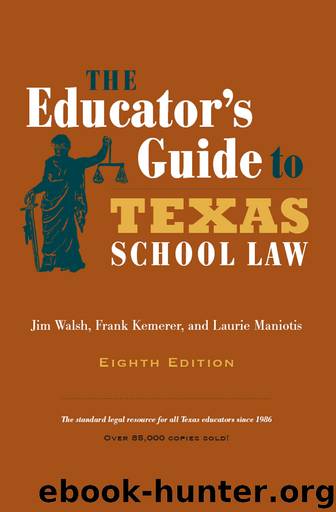The Educator's Guide to Texas School Law: Eighth Edition by Maniotis Laurie & Kemerer Frank & Walsh Jim

Author:Maniotis, Laurie & Kemerer, Frank & Walsh, Jim [Неизвестный]
Language: eng
Format: epub
Publisher: University of Texas Press
Published: 2014-09-14T21:00:00+00:00
School-Sponsored Student Publications
In 1988 the U.S. Supreme Court ruled in Hazelwood School District v. Kuhlmeier that school administrators have broad censorship powers over student newspapers produced under the auspices of the school as long as their actions are based on “legitimate pedagogical concerns” and as long as the school has not by policy or practice converted the school-sponsored student newspaper into a public forum where controversial views can be freely expressed. Justice Byron White differentiated interstudent communication from communication by students through channels maintained by the school. The former is personal in character and protected by the Court’s decision in Tinker v. Des Moines School District. The school has broad control over the latter, the five-person majority held, because it is part of the school curriculum. Channels of communication maintained by the school include not only school-sponsored publications, such as newspapers and yearbooks, but also theatrical productions and “other expressive activities that students, parents, and members of the public might reasonably perceive to bear the imprimatur of the school” (p. 569). For an activity to fall into the school-sponsored category, the Court noted, it must be supervised by a faculty member and be designed to impart particular knowledge or skills. Thus, a school literary magazine or school play produced under the supervision of a faculty member likely would be a school-sponsored channel of communication.
In the words of the Court, educators are entitled to exercise greater control over student expression through school-sponsored channels of communication “to assure that participants learn whatever lessons the activity is designed to teach, that readers or listeners are not exposed to material that may be inappropriate for their level of maturity, and that the views of the individual speaker are not erroneously attributed to the school” (p. 570). The Court thus recognized that, as publisher of a school newspaper or producer of a school play, a school may delete material that the school considers potentially disruptive, ungrammatical, poorly written, inadequately researched, biased or prejudiced, vulgar or profane, or unsuitable for immature audiences.
A Texas federal district court judge later applied the Hazelwood decision to a lawsuit brought by the author of an environmental textbook that was highly recommended by the commissioner of education but rejected by the State Board of Education (SBOE). The judge ruled that under Texas law selection of textbooks is a form of private speech exercised by government to instill its values in the instructional program and that under Hazelwood the decision not to accept a particular textbook serves a legitimate educational purpose. In affirming the judge’s decision in 2005, the Fifth Circuit took a more expansive view of SBOE authority over the curriculum. Rather than rely on the Hazelwood rationale, the appellate judges simply concluded that TEC §7.102(c)(22) gives the SBOE responsibility through textbook selection to see that the state’s own message is communicated through the curriculum. “The Board does not encourage a ‘diversity of views’ but instead ‘enlists private entities to convey its own message,’” the judges observed (p. 615). Therefore, neither
Download
This site does not store any files on its server. We only index and link to content provided by other sites. Please contact the content providers to delete copyright contents if any and email us, we'll remove relevant links or contents immediately.
| Antitrust | Civil Law |
| Emigration & Immigration | Federal Jurisdiction |
| Housing & Urban Development | Indigenous Peoples |
| Land Use | Public |
| Public Contract | Public Utilities |
| Urban, State & Local Government |
Killers of the Flower Moon by David Grann(3757)
Machine Learning at Scale with H2O by Gregory Keys | David Whiting(3655)
Oathbringer (The Stormlight Archive, Book 3) by Brandon Sanderson(2657)
Will by Will Smith(2590)
Once Upon a Broken Heart by Stephanie Garber(2531)
Guns, Germs and Steel by Diamond Jared(2206)
Borders by unknow(2121)
It Starts With Us (It Ends with Us #2) by Colleen Hoover(2054)
The Room Where It Happened by John Bolton;(2035)
Friends, Lovers, and the Big Terrible Thing by Matthew Perry(2014)
The Color of Law by Richard Rothstein(1824)
HBR's 10 Must Reads 2022 by Harvard Business Review(1702)
The Strength In Our Scars by Bianca Sparacino(1701)
A Short History of War by Jeremy Black(1677)
Water Rights and the Environment in the United States by John Burch(1607)
Examples & Explanations: Administrative Law by William F. Funk & Richard H. Seamon(1555)
515945210 by Unknown(1524)
Pharmacy Practice and The Law by Richard Abood(1497)
That Every Man Be Armed by Stephen P. Halbrook(1481)
